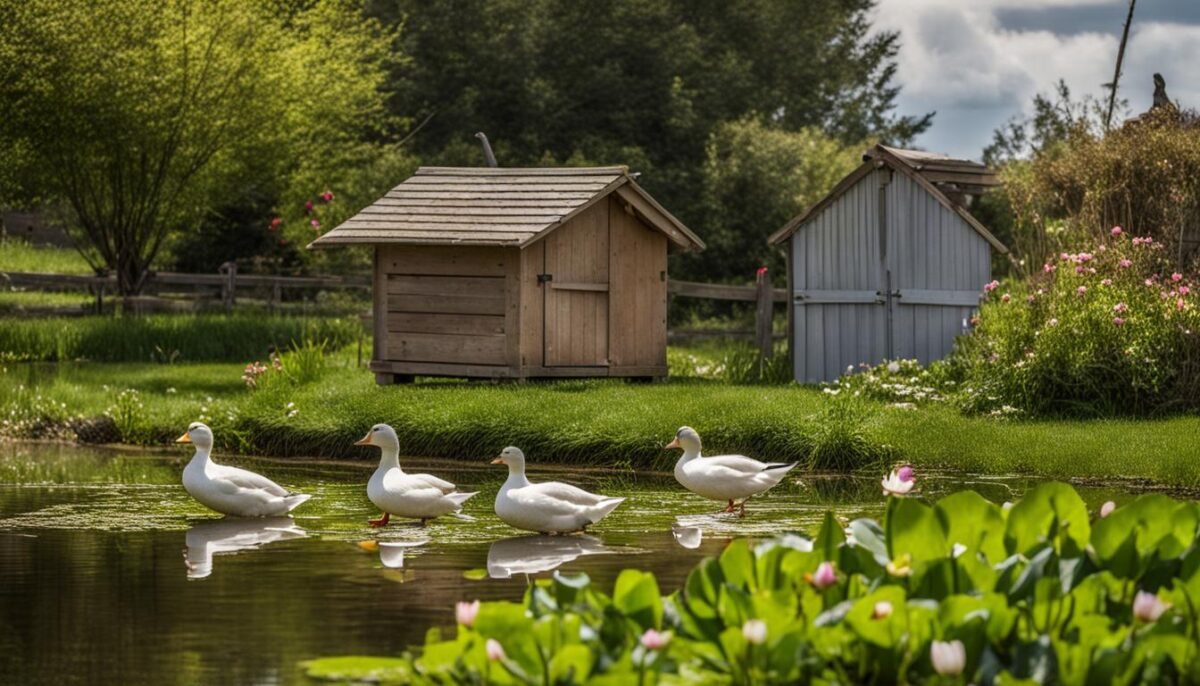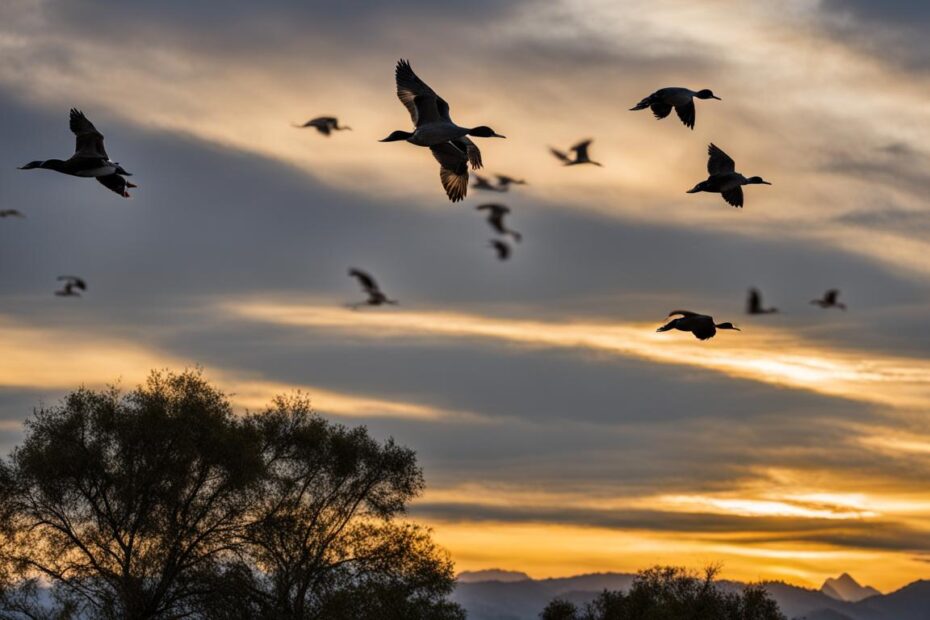Are you considering getting a pet duck, but worried about whether they will fly away? Understanding the flight capabilities of ducks is essential for their safety and well-being. In this article, we will explore the factors that can influence a pet duck’s ability to fly and provide tips to prevent them from flying away. Let’s dive in!
Key Takeaways:
- Pet ducks are capable of flying, but their flight abilities can vary depending on factors such as breed, age, weight, wing size, and muscle strength.
- The flight capabilities of domesticated ducks may differ from those of wild duck species due to selective breeding for specific traits.
- To prevent your pet ducks from flying away, provide a secure enclosure, duck-proof your yard, train them to stay in a designated area using positive reinforcement techniques, and consider wing clipping as an option.
- Understanding the flight capabilities of your specific breed of pet duck is crucial for meeting their specific needs and ensuring their well-being.
- Creating a safe and enriching environment for your pet ducks is essential for their happiness and health.
Understanding Duck Behavior and Habits
When it comes to the behavior and habits of ducks, there are several factors to consider. Ducks are capable of flying, but their flying abilities can vary depending on various factors such as breed, age, weight, wing size, and muscle strength. Some species of ducks, like the Mallard, are known for their ability to fly long distances and may migrate during certain seasons. On the other hand, domesticated ducks may have different flying abilities due to selective breeding for specific traits.
Domesticated breeds, like the Pekin duck, have been bred to be larger and heavier, which can hinder their flying ability compared to wild duck species. Additionally, young ducks may need time to develop the necessary muscle strength and coordination for sustained flight. It’s important to keep these factors in mind when considering whether pet ducks fly away.
To further understand the behavior and habits of ducks, it’s helpful to consider their natural instincts and behaviors. Ducks are social animals and live in flocks, which helps provide protection from predators and allows them to learn from one another. They also engage in activities such as preening, bathing, and foraging for food. Understanding these natural behaviors can aid in providing a proper and enriching environment for pet ducks.
| Factors | Impact on Flying Ability |
|---|---|
| Breed | Some breeds have shorter wingspans and heavier bodies, which can affect their ability to achieve sustained flight. |
| Weight | Heavier ducks may have more difficulty achieving sustained flight. |
| Wing Size | The size and shape of the wings can impact the efficiency of flight. |
| Muscle Strength | Ducks need strong muscles for sustained flight, which may take time to develop. |
By understanding the various factors that can influence the flying ability of pet ducks and the natural behaviors of ducks, pet owners can provide the proper care and environment to ensure the safety and well-being of their feathered friends.
Factors Affecting the Flying Ability of Pet Ducks
Several factors can influence the flying ability of pet ducks. Understanding these factors is essential for duck owners to provide suitable care and ensure the safety of their feathered friends.
Breed
The breed of a pet duck can play a significant role in its flying ability. Domesticated breeds, such as the Pekin duck, are often larger and heavier due to selective breeding for specific traits like meat or egg production. These characteristics can hinder their ability to achieve sustained flight compared to wild duck species.
Weight
The weight of a duck can affect its flying capabilities. Heavier ducks may struggle to achieve sustained flight, while lighter ones have an advantage. For pet ducks, their diet and overall health can influence their weight, so it’s important to provide a balanced diet and regular exercise to maintain a healthy weight.
Wing Size and Muscle Strength
The size of a duck’s wings and its muscle strength are crucial factors in determining its flying ability. Ducks with larger wings and well-developed muscles have better maneuverability and the potential to fly longer distances. Young ducks may need time to develop muscle strength and coordination for sustained flight.
| Factors | Impact on Flying Ability |
|---|---|
| Breed | Can hinder or enhance flying ability depending on the breed |
| Weight | Heavier ducks may struggle to achieve sustained flight |
| Wing Size and Muscle Strength | Larger wings and well-developed muscles contribute to better flying capabilities |
“The breed, weight, wing size, and muscle strength are important factors that can influence the flying ability of pet ducks.”
By considering these factors, duck owners can better understand their pet ducks’ flying ability and make informed decisions regarding their care and safety.
Tips for Keeping Pet Ducks Safe and Preventing Flight
When it comes to keeping pet ducks safe and preventing them from flying away, there are several key strategies to consider. By following these tips, you can ensure the well-being of your feathered companions and minimize the risk of them taking flight.
Creating a Secure Enclosure
The first step in preventing pet ducks from flying away is to provide them with a suitable and secure enclosure. This can include duck-proofing your yard by ensuring fences are tall and secure, with no gaps or holes that ducks can squeeze through. Additionally, consider covering any ponds or water features to prevent ducks from flying off to explore neighboring bodies of water.
It’s important to note that ducks are skilled climbers, so be sure to incorporate measures to prevent them from escaping over the top of the enclosure as well. This can be achieved by adding a secure roof or mesh netting to keep them contained.
Training and Positive Reinforcement
Training pet ducks to stay in a designated area can be an effective way to prevent flight. Start by establishing a specific spot where you want your ducks to remain, such as a fenced yard or a dedicated pen. Gradually introduce them to this area and use positive reinforcement techniques, such as treats or praise, to reward them for staying within the boundaries. Consistency and repetition are key to successful training.
It’s important to note that training may take time and patience, as ducks have a natural instinct to explore and roam. However, with consistent training and positive reinforcement, you can help them understand where they should stay and minimize the risk of them flying off.
| Tip | Description |
|---|---|
| Duck-proof your yard | Ensure fences are tall and secure, with no gaps or holes. |
| Cover ponds and water features | Prevent ducks from flying off to explore neighboring bodies of water. |
| Add a secure roof or mesh netting | Prevent ducks from escaping over the top of the enclosure. |
| Establish a designated area | Create a specific spot where you want your ducks to stay. |
| Use positive reinforcement | Reward ducks with treats or praise for staying within the boundaries. |
| Be patient and consistent | Training may take time, but with persistence, ducks can learn to stay. |
Consider Wing Clipping
Another option to prevent pet ducks from flying away is wing clipping. This technique involves trimming a portion of the primary flight feathers on one or both wings to limit their ability to achieve sustained flight. It’s crucial to have wing clipping done by a veterinarian or experienced professional to ensure it is done safely and without causing harm to the duck.
It’s important to note that wing clipping is a temporary solution and will eventually require maintenance as feathers regrow. Additionally, some duck owners may choose not to clip their ducks’ wings for various reasons, including the desire to maintain their natural behavior or the ability to fly in larger enclosures. Ultimately, the decision to clip wings should be made based on the individual circumstances and preferences of the duck and its owner.
By implementing these tips, you can create a safe and secure environment for your pet ducks, minimizing the risk of them flying away while ensuring their well-being and happiness.
Understanding the Flight Capabilities of Ducks
Ducks are known for their ability to fly, but the flight capabilities of domesticated ducks may differ from their wild counterparts. Domesticated breeds, such as the Pekin duck, have been selectively bred for specific traits like meat or egg production rather than flight. This breeding process has resulted in shorter wingspans and heavier bodies, which can affect their ability to achieve sustained flight. While domesticated ducks can still flap their wings and take short flights, their ability to fly long distances may be diminished.
Unlike wild duck species that may migrate during certain seasons, raising flightless domestic ducks is a possibility. These domesticated breeds are often unable to fly long distances due to their physical characteristics. However, it is important to note that individual circumstances can vary, and some ducks may still have the capability to fly short distances or maintain limited flight abilities. Therefore, it is crucial for duck owners to understand the flight capabilities of the specific breed they have and provide appropriate care accordingly.
The Flight Capabilities of Domesticated Ducks:
| Breed | Flight Capability |
|---|---|
| Pekin Duck | Limited flight or flightless |
| Muscovy Duck | Short flights, limited flight |
| Khaki Campbell Duck | Short flights, limited flight |
In cases where flight prevention is desired, wing clipping is a commonly used technique. This process involves trimming a portion of the primary flight feathers on one or both wings to limit the duck’s ability to achieve sustained flight. However, wing clipping should be done carefully and preferably by a veterinarian or an experienced professional to avoid causing harm or discomfort to the duck.

Creating a safe and enriching environment for pet ducks is essential, regardless of their flight capabilities. Providing suitable enclosures that meet their needs for space, shelter, and protection from predators is crucial. Additionally, incorporating features like pools or ponds for swimming, appropriate feeding and drinking areas, and opportunities for social interaction can contribute to keeping pet ducks happy and healthy.
The Importance of Wing Clipping for Pet Ducks
Wing clipping is a crucial practice for pet duck owners who want to prevent their ducks from flying away. By trimming a portion of the primary flight feathers on one or both wings, wing clipping limits the ducks’ ability to achieve sustained flight. This simple procedure can help ensure the safety and security of pet ducks, especially in outdoor environments where they may be at risk of escaping or getting lost.
One of the key benefits of wing clipping is that it allows pet ducks to be safely housed in outdoor enclosures without the risk of them flying away. A securely enclosed space provides ducks with the freedom to roam, explore, and engage in natural behaviors, while also mitigating the potential dangers associated with unrestricted flight. Wing-clipped ducks can still enjoy the benefits of outdoor living without the risk of getting lost or encountering hazardous situations.
It’s important to note that wing clipping should only be performed by a veterinarian or an experienced professional to ensure the safety and well-being of the ducks. Improper wing clipping can cause discomfort, stress, and even injury to the ducks. A professional will know the correct technique and will consider factors such as the breed, age, and overall health of the duck before performing the procedure. Seeking professional advice and assistance is essential to avoid any negative consequences.
In summary, wing clipping plays a vital role in keeping pet ducks safe and secure. By limiting their flight capabilities, it allows pet owners to provide a controlled and protected environment for their ducks to thrive. Remember to consult a professional to ensure the wing clipping is done correctly, prioritizing the well-being and welfare of the ducks.
Creating a Safe and Enriching Environment for Pet Ducks
When it comes to keeping pet ducks happy and safe, providing them with a suitable and enriching environment is essential. Designing a well-planned duck enclosure can ensure that your feathered friends have everything they need for a thriving and contented life.
Consider incorporating features like a pool or pond for swimming, as ducks are natural water-loving creatures. Providing them with a space to engage in their natural behaviors will help keep them happy and healthy. Additionally, make sure to include suitable feeding and drinking areas within the enclosure, as well as opportunities for social interaction.
Designing a secure enclosure is crucial for the safety of your pet ducks. Ensure that the fences are tall and sturdy to prevent any potential escapes. Remove any potential escape routes such as gaps or holes in the fencing. Creating a roof or cover for the enclosure can protect your ducks from predators such as birds of prey. It’s important to create an environment that not only keeps your ducks safe but also allows them to express their natural behaviors.
Sample Duck Enclosure Design
Here’s an example of a duck enclosure design that provides a safe and enriching environment for your pet ducks:
| Feature | Description |
|---|---|
| Swimming Area | A pool or pond with a shallow area for ducks to swim and clean themselves. |
| Feeding and Drinking Area | A designated space with easy access to food and water, preferably with duck-specific feeders and drinkers. |
| Shelter | A covered area with suitable bedding material for ducks to seek shelter from extreme weather conditions. |
| Social Interaction Area | A space with adequate room for ducks to socialize and engage in natural behaviors, such as foraging or preening. |
| Fenced and Predator-Proof | A secure enclosure with tall and sturdy fencing, covering the top to prevent predators from accessing the ducks. |
By creating a safe and enriching environment for your pet ducks, you can ensure their well-being and happiness. Remember to regularly inspect and maintain the enclosure to address any potential safety risks, and provide opportunities for mental and physical stimulation. Keeping pet ducks safe and happy is a rewarding experience that can strengthen the bond between you and your feathered companions.

Reasons Why Pet Ducks May Fly Away
While pet ducks are generally domesticated and may not have the same flight capabilities as their wild counterparts, there are several reasons why they may still attempt to fly away. Understanding these reasons can help duck owners take appropriate measures to prevent their beloved pets from escaping.
1. Natural Instincts
Ducks, regardless of their domestication, have natural instincts for migration. Even if they have been selectively bred to be flightless, these instincts can still drive them to attempt to fly away. In certain seasons or situations, ducks may feel a strong urge to join migrating flocks or search for new territories, leading them to take flight.
2. Seeking Mates
If pet ducks are not already paired with a mate, they may attempt to fly away in search of a partner. This behavior is especially common during the breeding season when ducks have a strong desire to find a suitable mate. It is important to provide proper companionship for pet ducks to reduce the likelihood of them seeking mates elsewhere.
3. Startling or Scary Situations
Ducks can be easily startled by loud noises, sudden movements, or unfamiliar situations. If they feel threatened or scared, they may take flight as a means of escaping perceived danger. Creating a calm and safe environment for pet ducks is essential to minimize the chances of them trying to fly away.
By understanding the natural instincts and behaviors of ducks, duck owners can take proactive steps to prevent their pet ducks from flying away. Providing a secure and enriching environment, ensuring proper companionship, and minimizing potential stressors can help keep pet ducks happy, safe, and close to home.
Ensuring the Safety of Pet Ducks when Flying
Pet ducks may have the ability to fly, and it is important to take necessary precautions to ensure their safety when they are airborne. Supervision is crucial during flight sessions to monitor their behavior and intervene if needed. Providing a safe landing area is essential to prevent injuries. It should be free of hazards such as sharp objects, electrical wires, or dense vegetation that could obstruct their landing or cause harm.
In addition to a safe landing area, it is important to keep pet ducks away from potential dangers while they are flying. This includes avoiding busy roads or areas with heavy traffic that could pose a risk of accidents. It is also crucial to protect them from predatory animals that may be attracted to their flight or vulnerable landing moments. Creating a secure and enclosed space for flight sessions can help minimize these risks.
Ensuring the Safety of Pet Ducks during Flight:
- Supervise the flight sessions and intervene if necessary.
- Provide a safe landing area free of hazards.
- Avoid flying near busy roads or areas with heavy traffic.
- Protect pet ducks from predatory animals during flight.
- Create a secure and enclosed space for flight sessions.
By prioritizing the safety of pet ducks during flight, owners can enjoy watching their feathered companions soar while ensuring their well-being. Remember, each pet duck is unique, and it is important to understand their individual flight capabilities and limitations to provide the best possible care.
Table: Potential Hazards to Avoid during Pet Duck Flight Sessions
| Hazard | Prevention Measures |
|---|---|
| Sharp objects on landing area | Regularly inspect and remove any debris or sharp objects from the landing area. |
| Electrical wires and cables | Ensure flight sessions are conducted away from any electrical hazards. |
| Busy roads or heavy traffic areas | Avoid flying near roads or areas with heavy traffic to prevent accidents. |
| Predatory animals | Create a secure and enclosed space for flight sessions to protect pet ducks from predators. |
| Unsuitable weather conditions | Do not fly ducks in adverse weather conditions such as strong winds, heavy rain, or storms. |

Conclusion
In conclusion, when raising flightless domestic ducks, it is essential to prioritize their safety and well-being. Understanding the importance of wing clipping for pet ducks is crucial to prevent them from flying away and getting lost or injured. Wing clipping, when done carefully, limits their ability to achieve sustained flight and keeps them within a designated area.
Moreover, keeping pet ducks happy and safe involves creating a suitable environment that meets their needs. Designing a secure duck enclosure with enough space, shelter, and protection from predators contributes to their overall well-being. Incorporating features like pools or ponds, appropriate feeding and drinking areas, and opportunities for social interaction enhances their happiness and mental stimulation.
By taking into account the unique characteristics and flight limitations of domesticated duck breeds, owners can ensure the optimal care for their feathered companions. Remember, raising flightless domestic ducks requires responsible ownership and a commitment to providing them with the necessary care, attention, and security they need to thrive.
FAQ
Do pet ducks fly away?
Ducks are capable of flying, but the extent to which they fly can vary depending on factors such as breed, age, weight, wing size, and muscle strength.
How can I prevent my pet ducks from flying away?
To prevent pet ducks from flying away, it is important to provide them with a suitable and secure enclosure. This can include implementing measures to duck-proof your yard, training them to stay in a designated area, and considering wing clipping as an option.
Can domesticated ducks fly as well as wild ducks?
Domesticated ducks may have different flying abilities compared to wild duck species due to selective breeding for specific traits. Some domesticated breeds, like the Pekin duck, have been bred to be larger and heavier, which may hinder their flying ability.
What is wing clipping?
Wing clipping is a technique used to prevent pet ducks from flying away. It involves trimming a portion of the primary flight feathers on one or both wings to limit their ability to achieve sustained flight.
How can I create a safe and enriching environment for my pet ducks?
Providing a suitable duck enclosure that meets their needs for space, shelter, and protection from predators is crucial. Incorporating features like pools or ponds for swimming, suitable feeding and drinking areas, and opportunities for social interaction can contribute to keeping pet ducks happy and healthy.
Why do pet ducks fly away?
There can be various reasons why pet ducks may fly away, including being startled or scared, searching for a mate if they are not already paired, or responding to natural instincts for migration.
How can I ensure the safety of my pet ducks when they are flying?
It is important to supervise their flight sessions, provide a safe landing area, and keep them away from potential hazards such as busy roads or areas with predatory animals.


